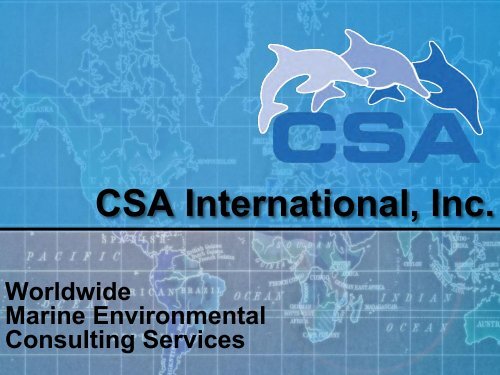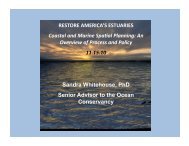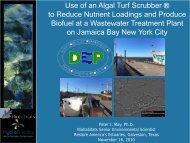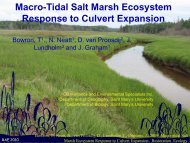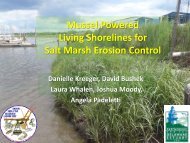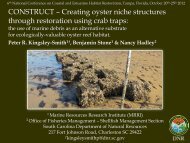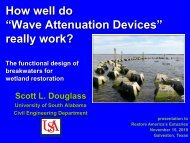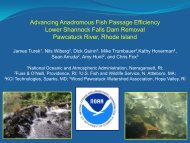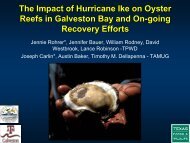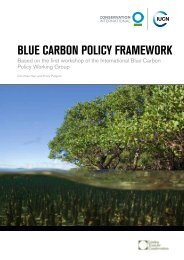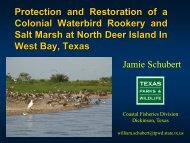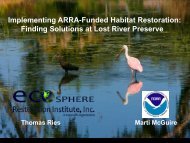MODIFIED SHOVEL METHOD - Restore America's Estuaries
MODIFIED SHOVEL METHOD - Restore America's Estuaries
MODIFIED SHOVEL METHOD - Restore America's Estuaries
Create successful ePaper yourself
Turn your PDF publications into a flip-book with our unique Google optimized e-Paper software.
CSA International, Inc.<br />
Worldwide<br />
Marine Environmental<br />
Consulting Services
Development of the “Modified Shovel Method” and<br />
“Pneumatic Plugger Method”<br />
Presented by: Raymond F. Dennis III, PWS
Purpose<br />
• Provide a Development Overview<br />
– “Modified Shovel Method” (MSM)<br />
– “Pneumatic Plugger Method” (PPM)<br />
• With Focus on the Advantages and Adaptability of<br />
– Tools<br />
– Field operations
Seagrass Transplanting Perception<br />
• “…the track record for successful mitigation<br />
projects remains variable.”<br />
• “Spectacular failures have created a lasting<br />
impression that seagrass restoration is still an<br />
experimental management tool.”<br />
Fonseca, M.S., et al. 1998. Guidelines for the Conservation and<br />
Restoration of Seagrasses in the United States and Adjacent<br />
Waters. NOAA Coastal Ocean Program Decision Analysis Series<br />
No. 12. NOAA Coastal Ocean Office, Sliver Spring, MD. 222 pp.
Seagrass Transplanting Concerns<br />
• Project Requirements<br />
– Transplanting Quantity<br />
– Donor Material Quality<br />
– Distance: Donor to Recipient Site<br />
– Project Site Conditions: Access Limitations<br />
– Which Method / Approach<br />
– Survivability vs. Success Criteria/Target<br />
• Economic Feasibility
© Stantec 2001<br />
© Stantec 2008<br />
Insert photos<br />
© Stantec 2001<br />
<strong>MODIFIED</strong> <strong>SHOVEL</strong> <strong>METHOD</strong><br />
(MSM)
Port Manatee Expansion Project<br />
• Seagrass Transplanting<br />
0.78 ha (1.92 ac)<br />
• Transport Distance<br />
2.41 km (1.5 mi)<br />
• Site Conditions<br />
Limited Access<br />
• Success Criteria<br />
• Completion Time<br />
60 days<br />
© Stantec 2006
Fonseca, M.S. 1994. A guide to<br />
planting seagrasses in the Gulf of<br />
Mexico. Texas A&M Sea Grant<br />
College Program, TAMU-SG-94-601.<br />
Existing Methods
Modified Shovel Method<br />
• Planting Unit (PU) Size<br />
– 0.06 m 2 (0.69 ft 2 ) > other methods<br />
– Intact sediments<br />
– More short shoots<br />
– More apical meristems<br />
– Complete recovery of donor area<br />
• Collection / Installation Rate<br />
– 2 work minutes per PU<br />
© Stantec 2003
Modified Shovel Method<br />
• Adaptable Transport System<br />
– Plastic sod trays<br />
– Ergonomic handling<br />
– Floats, boats, trucks, trailers, etc.<br />
• Scalable Field Approaches<br />
– Separate / simultaneous operations<br />
– Adjustable production rate<br />
– Local or unskilled labor<br />
– Economic feasibility
Post Transplanting – Results<br />
© Stantec 2001<br />
Total Area of Seagrass Removal<br />
0.78 ha (1.92 ac)
Post Transplanting – Results<br />
© Stantec 2002<br />
© Stantec 2002<br />
Mitigation Sites 4 & 6 Totaling 3.85 ha (9.51 ac)<br />
• 130,000 Planting Units Installed in 26 Working Days<br />
• Total of 3.11 ha (7.68 ac) with % Coverage ≥ Reference<br />
Sites<br />
© Stantec 2006
Secondary Transplanting<br />
• 33,000 Planting Units Installed<br />
• Total Area with % Coverage ≥ Reference Sites<br />
• Mitigation Site 7 Totaling 6.52 ha (16.11 ac)<br />
© Stantec 2006<br />
© Stantec 2006
© Stantec 2010<br />
© Stantec 2010<br />
© Stantec 2003<br />
© Stantec 2010<br />
© Stantec 2010<br />
© Stantec 2010<br />
PNEUMATIC PLUGGER <strong>METHOD</strong><br />
(PPM)
Port Manatee Remedial Activities<br />
© Stantec 2007
Physiological Factors<br />
Bare root turtle grass rhizome<br />
© Lewis Env 2008
Common Mistake #1<br />
WRONG<br />
RIGHT<br />
Same grade<br />
or slightly<br />
deeper<br />
© Lewis Env 2008
Common Mistake # 2<br />
6 " or smaller – few apical meristems salvaged<br />
8 " or larger – minimum of 1-3 apical meristems salvaged<br />
40% Larger<br />
More rapid<br />
establishment<br />
and growth<br />
© Lewis Env 2008
Pneumatic Plugger Method<br />
• Based on the core method<br />
• Capable of collecting<br />
deeper rooted species<br />
• Uses compressed air to<br />
break the suction pressure<br />
– 2.5 work minutes per PU<br />
• Adaptable transport system<br />
• Scalable field approach
Post Transplanting – Results<br />
Year 2<br />
© Stantec 2009<br />
30 Days © Stantec 2007<br />
• 1,001 PUs installed<br />
• 100% recovery of donor areas<br />
• PU survival of 75%<br />
• 62% mean PU expansion<br />
Year 3<br />
© Stantec 2010
MSM and PPM Summary<br />
• Higher Potential for Survivability and Establishment<br />
• Recovery of Donor Areas<br />
• Adaptable for Unique Site / Project Conditions<br />
– Water depths<br />
– Transport distances<br />
– Transport methods<br />
– Site accessibility and staging<br />
– Local / unskilled labor<br />
• Scalable Field Approaches<br />
• Economically Feasible
Final Thought<br />
• “Experimentation with adjustments to methodology<br />
is typical for any agricultural practice”<br />
• “…adaptation to local conditions and logistics is<br />
logical”<br />
• “…experimental manipulation is unnecessary for<br />
effective seagrass restoration, because there are<br />
proven, standard methods”<br />
© Stantec 2001<br />
Fonseca, M.S. 2011. Addy Revisited: What has<br />
changed with Seagrass Restoration in 64 Years<br />
Special Invited Issue: Ecological Restoration 29 (1-<br />
2):73-81.


